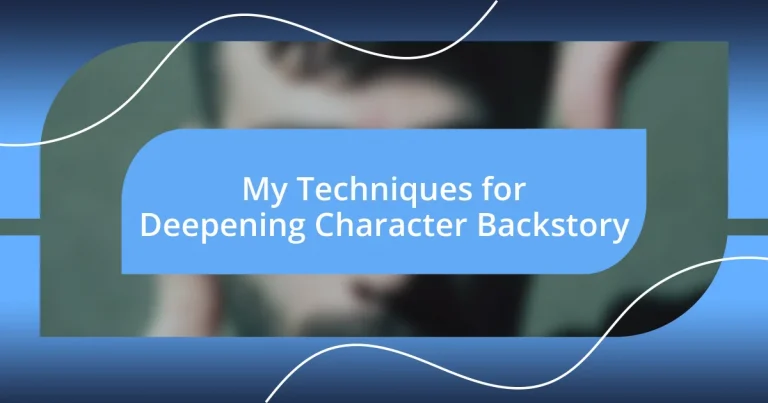Key takeaways:
- Understanding and developing character backstory is crucial for shaping their motivations, personality, and relatability, allowing readers to connect deeply with the narrative.
- Detailed backstories not only add emotional depth and complexity to characters but also serve as pivotal plot devices that can drive narrative tension and themes.
- Effective techniques for building character histories include character interviews, timeline creation, and exploring relationships, all of which can enhance the authenticity and engagement of the story.
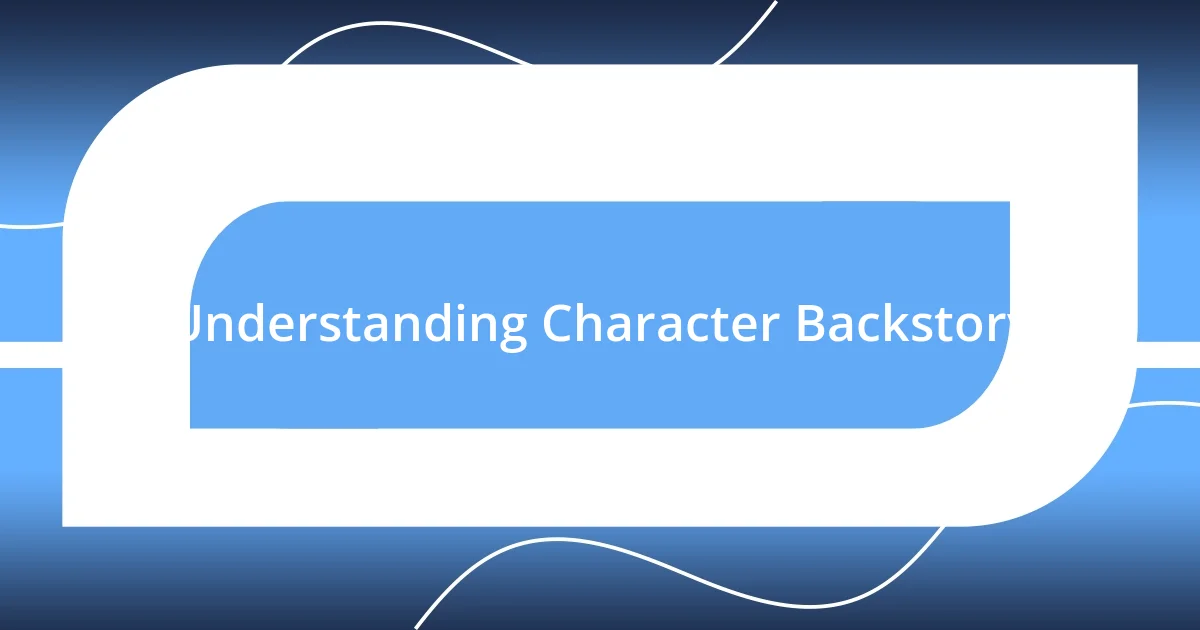
Understanding Character Backstory
Understanding character backstory is essential because it helps to shape not only the character’s motivations but also their personality. When I craft a character, I often ask myself, “What moments in their past have left lasting impressions?” For instance, I once developed a character who lost a parent at a young age; exploring how this loss influenced their relationships added depth that readers could relate to.
Diving deeper into a character’s history can reveal hidden fears or desires that drive their actions. I remember one character I wrote who grew up in a strict household; this led them to rebel in unexpected ways later in life. It’s fascinating to see how such experiences can create dichotomies in a character’s personality, prompting the question: how do our past trials shape us as individuals?
Origin stories frame a character’s journey and provide context for their choices. I often reflect on my own life and how the experiences that shaped me—like overcoming challenges or embracing failures—parallel those of my characters. This connection not only enriches my writing but also invites readers to ponder their own stories. When was the last time you reflected on how your past has influenced your present?
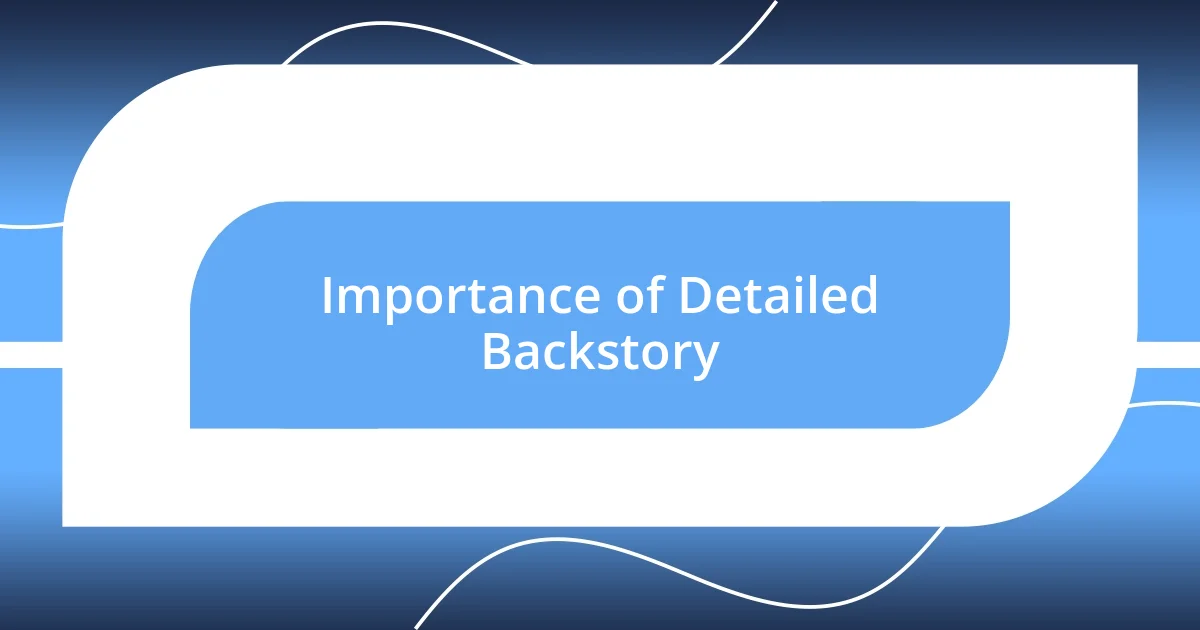
Importance of Detailed Backstory
Detailed backstories are critical because they breathe life into characters, transforming them from mere words on a page into believable individuals. I find that when I dig into a character’s past, it often uncovers layers of emotion and drive that propel the narrative forward. For instance, a character who once suffered betrayal might act defensively in relationships, resonating with anyone who’s endured similar heartbreak. This connection not only enriches the character but also fosters empathy from the reader.
When a character has a well-defined backstory, their actions and decisions become more engaging and relatable. I remember crafting a character whose childhood revolved around discovery and adventure, which later influenced their impulsive decisions as an adult. Such moments highlight how our formative experiences shape our instincts and choices. This depth allows readers to follow along more intimately, almost feeling they know the character personally—fostering a stronger bond with the story.
Moreover, rich backstories can serve as pivotal plot devices. A character’s history may reveal why they fear abandonment or seek out chaos in their life, giving the audience a lens to understand their internal conflicts. I’ve observed that integrating such nuances often leads to unexpected plot twists; characters make choices that echo their past, sometimes in ways that surprise even me as the writer! How wonderful is it to see characters come alive through their histories, reminding us of our own?
| Importance of Backstory | Examples |
|---|---|
| Creates Relatability | A character’s trauma resonates with readers’ own experiences. |
| Drives Character Motivation | Backstory explains decisions and actions, making them believable. |
| Adds Depth to Narrative | Reveals how past experiences shape present behavior, enriching the plot. |
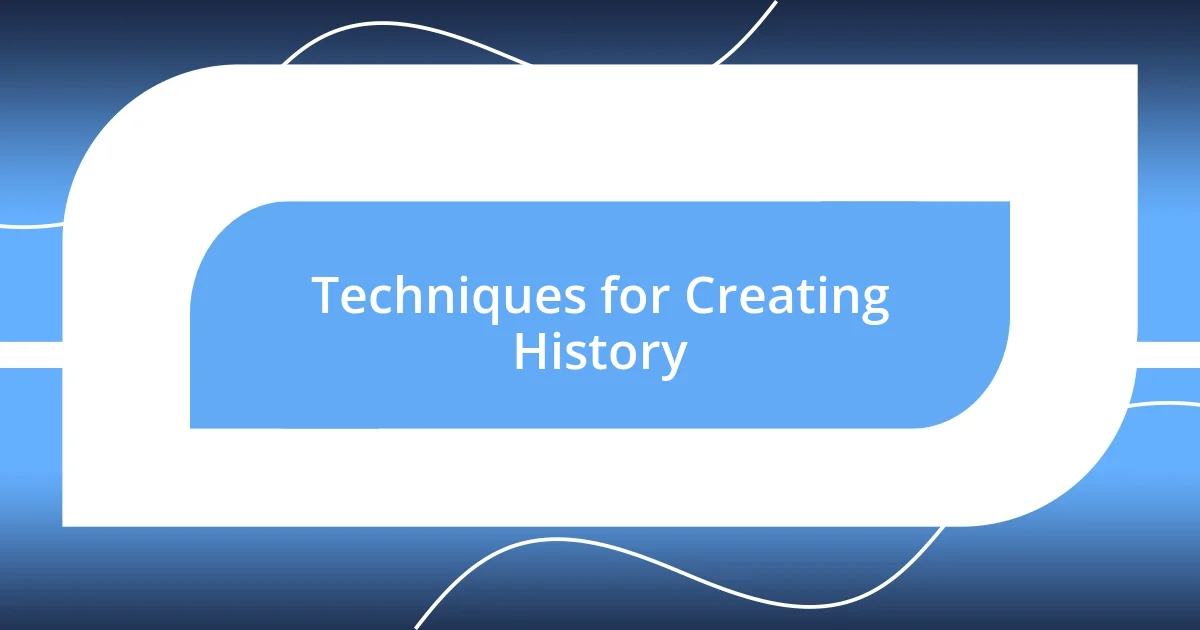
Techniques for Creating History
Creating a history for your characters is an enriching process that can deeply influence how they resonate with readers. I’ve found that approaching this task as if I were peeling back layers of an onion often yields the most rewarding results. Each layer reveals emotions tied to significant events in the character’s life, shaping their habits and perspectives. For example, once I explored a character whose formative years were filled with instability; this instability instilled a fear of commitment, influencing their relationships in profound ways. As I wrote, I felt my own experiences of uncertainty creeping into the narrative, enriching it with authenticity.
Here are some techniques I utilize to build character histories effectively:
- Character Interviews: I ‘interview’ my characters, asking them questions about their past, dreams, and fears. This often uncovers emotions I may not have considered.
- Timeline Creation: Drafting a timeline of key life events helps me visualize the character’s growth and major turning points.
- Imagery and Senses: Incorporating sensory details related to past experiences brings those memories to life, making them tangible for the reader.
- Exploring Relationships: I consider how various relationships have shaped the character, whether they are familial, platonic, or romantic, as these connections often define motives.
- Writing Prompts: Using specific writing prompts related to key life events can spark new ideas and deepen the character’s emotional depth.
Each method has its unique advantages, and I love how they can bring surprising nuances to a character’s story. When I took the time to flesh out a side character’s past—a small-town girl with dreams of leaving for the city—I discovered how her small victories and disappointments made her fiercely independent. That insight transformed her into someone readers could root for; it’s remarkable how a character’s history can ignite empathy and connection on the page.
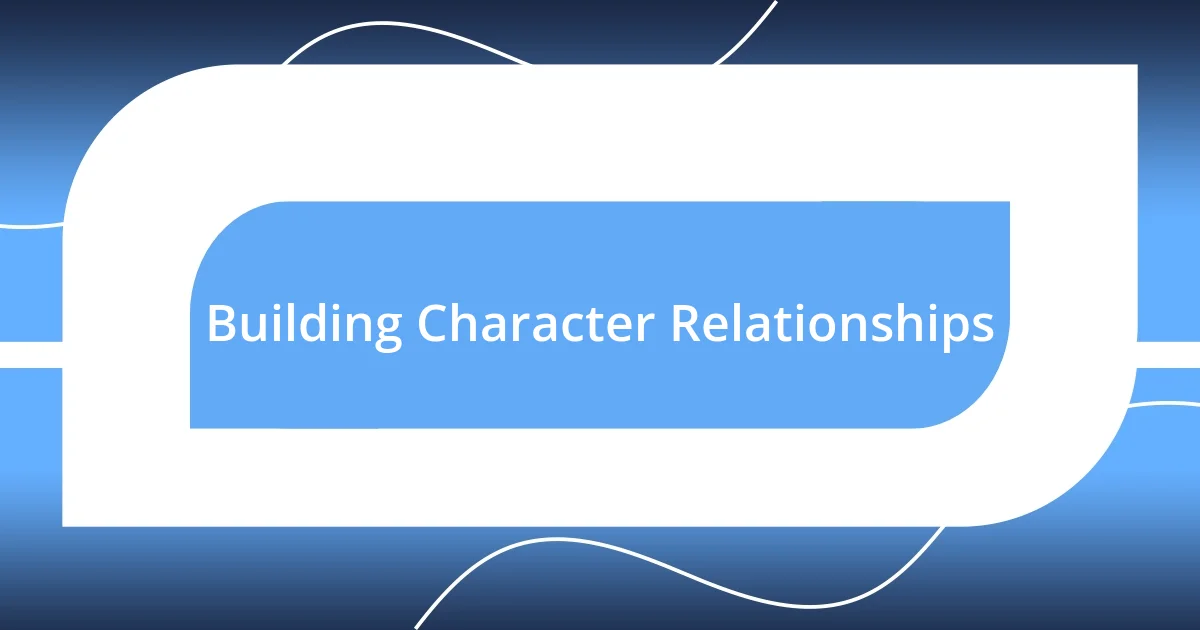
Building Character Relationships
Building character relationships is a fascinating journey that invites us to explore the bonds that connect our characters to one another. I often find that these relationships are the backbone of any story, providing a rich canvas on which I can paint their interactions. For instance, I once created two characters who were childhood friends, only to uncover the deep-seated rivalry that developed between them as they grew older. Reflecting on my own friendships, I realized how such dynamics can shift over time, and this insight added a compelling layer to their relationship.
In crafting these connections, I pay close attention to how past experiences mold not just individual characters, but also their interactions. I remember developing a character whose relationship with her mother was fraught with tension due to unmet expectations. This backstory played a crucial role when she faced a similar situation with a friend, and I could see how the emotional weight of her past affected her decisions. Have you ever noticed how unresolved conflicts can spill over into new relationships? It’s almost as if we carry echoes of our past into each new connection we make.
Moreover, I believe that showing vulnerability can deepen character relationships significantly. When characters reveal their fears or insecurities to one another, it creates an authentic bond that resonates with readers. I recall a scene where a character bravely admitted his fear of abandonment to a new romantic interest, which not only transformed their relationship but also allowed readers to empathize with him on a deeper level. This moment highlights how openness can lead to growth, both for the characters and the story itself. How do you think vulnerability shapes the relationships in your writing? To me, it’s an essential ingredient for genuine connection.
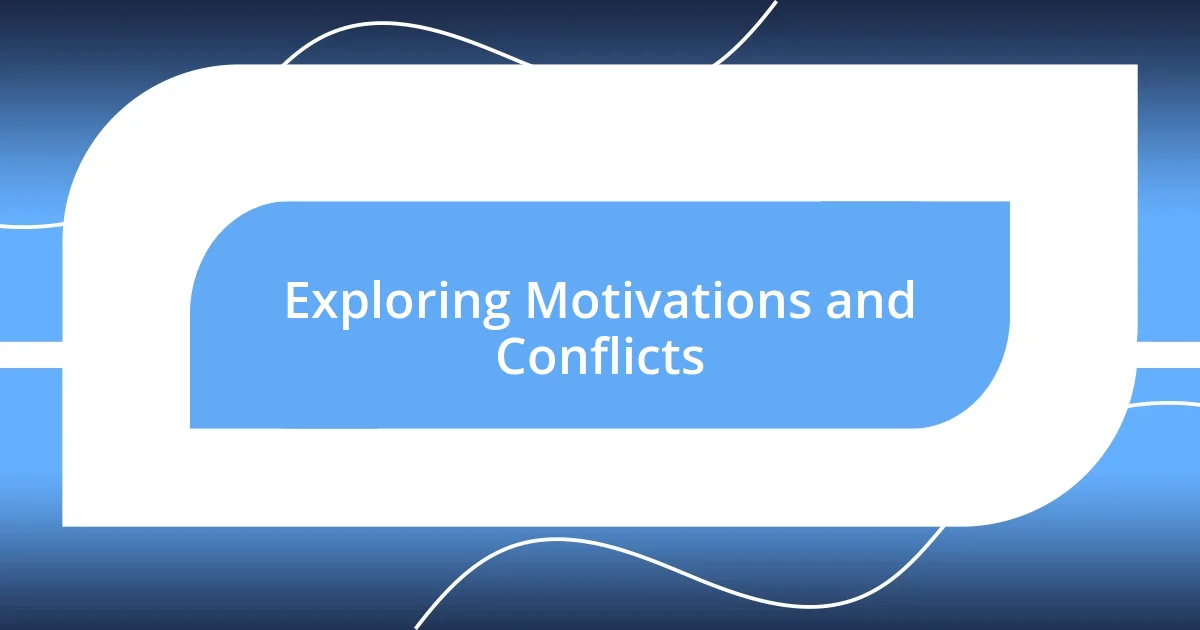
Exploring Motivations and Conflicts
Exploring motivations and conflicts in characters is where the heart of storytelling truly beats. I’ve often realized that understanding what drives a character—be it ambition, fear, or love—can transform their journey. For instance, while developing a protagonist who yearned for approval from his estranged father, I found that his relentless pursuit of success stemmed from both admiration and deep-seated resentment. This duality not only shaped his choices but also created tension that kept readers hooked.
Conflicts can emerge from clear internal struggles, but I’ve also seen how they can stem from external pressures. Take, for example, a character caught in familial expectations versus personal dreams. I remember when I wrote about a young woman torn between her desire to be an artist and her family’s insistence on a traditional career. This inner turmoil was palpable as it mirrored my own battles with expectations in my life, making the narrative resonate with authenticity. How often do we find ourselves in similar situations, where our dreams clash with what’s expected of us?
I’ve learned that layering conflicts can provide incredible depth to a character. One time, while creating a flawed hero, I realized that his quest to protect his family created a rift with his best friend, who felt neglected. This conflict reflected a universal issue—balancing personal ambition with the needs of loved ones. Reflecting on moments like this invites readers to think critically about their own priorities. When characters grapple with complex motivations and conflicts, it not only drives the narrative forward but also invites readers to examine their own lives in a new light. Don’t you find that such reflections often linger long after the final page?
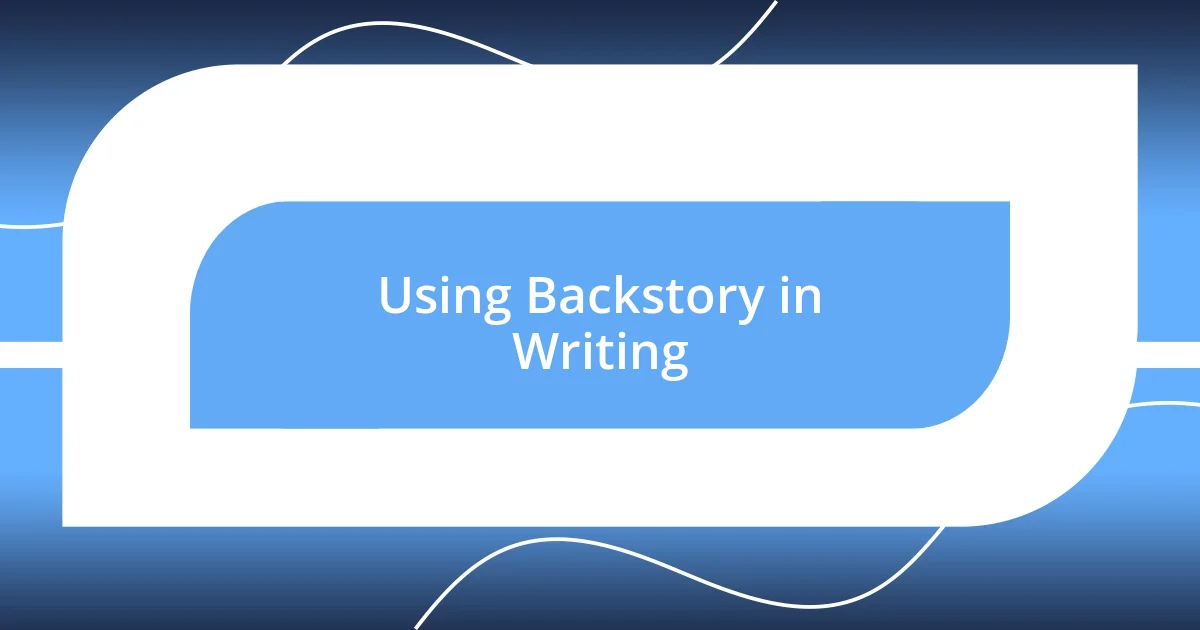
Using Backstory in Writing
Using backstory in writing is a powerful tool that can add layers to a character’s actions and personality. I’ve seen firsthand how a character’s past informs their decisions in the present, adding depth and relatability. For instance, when I wrote about a character who had faced abandonment in childhood, that experience drove her to overcommit in her adult relationships, seeking stability where she once found uncertainty. It’s intriguing how such backstory threads can weave into the character’s current struggles, isn’t it?
I often contemplate the balance needed in revealing backstory. Too much at once can overwhelm the reader, while too little can leave them confused. I recall a situation where I introduced a character’s traumatic past slowly, allowing readers to piece together how it shaped her interactions with others. This gradual revelation not only maintained suspense, but also made the character’s growth feel more rewarding. Have you noticed how the timing of backstory revelation can change the entire tone of a narrative?
In my experience, backstory can also enhance conflict, fueling not just character motivations but also their relationships with others. For example, I crafted a character who initially seemed cold and detached but had a deep-seated fear of intimacy stemming from a past betrayal. As the story unfolded, her interactions with a potential love interest became fraught with tension, compelling readers to root for her. I often wonder, how do our characters’ histories influence not only their paths but also the paths of those around them? It’s a fascinating dance that can elevate the narrative to new heights.
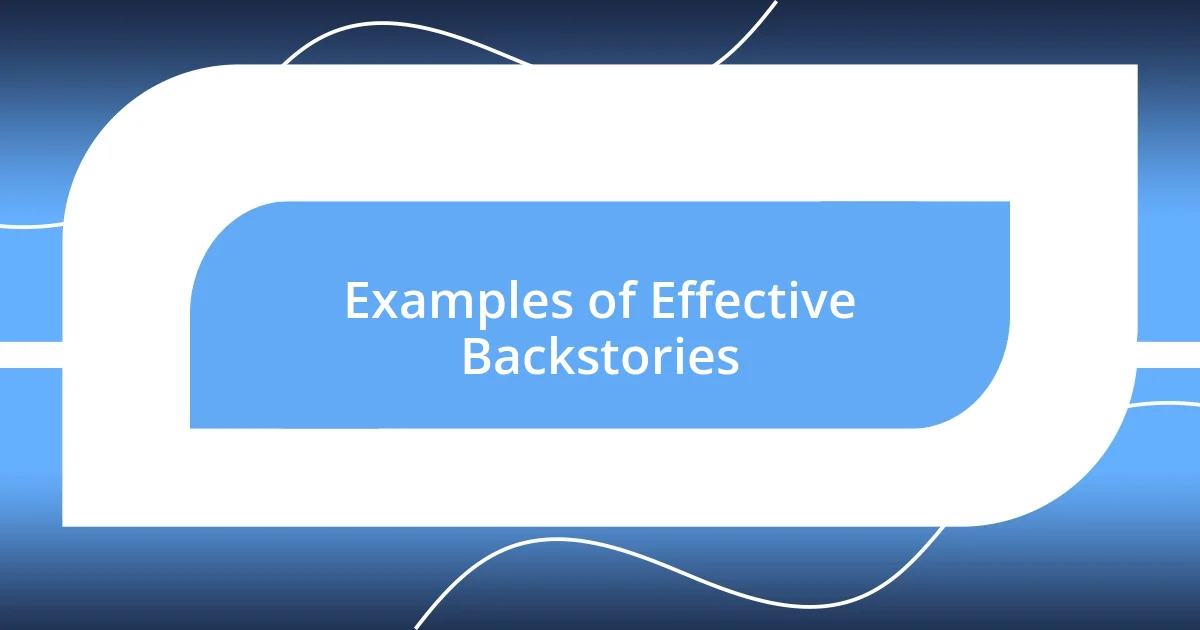
Examples of Effective Backstories
One of my favorite examples of an effective backstory is from the novel “The Kite Runner.” The protagonist, Amir, carries the weight of a childhood betrayal that not only haunts him but shapes his actions throughout the story. When I first read about Amir’s struggle for redemption, it struck a chord with me. How often do we wrestle with our past mistakes, trying to patch up the fragments of our broken relationships? Amir’s backstory isn’t just his; it mirrors a universal search for forgiveness and the longing for acceptance.
In my own writing, I explored a character whose intense fear of failure stemmed from her perfectionist parents. As she faced challenges in her career, it was deeply emotional to illustrate her internal conflict, showing how those early pressures affected her choices. I found myself reflecting on times when I felt that same anxiety—the fear of disappointing those I love. Doesn’t it create a powerful connection when readers can resonate with a character on such a personal level?
Another poignant backstory example is in “The Great Gatsby.” Jay Gatsby’s rise from humble beginnings to wealth was fueled by his desire for recognition and acceptance. I remember feeling a mix of admiration and sadness as I delved into Gatsby’s relentless pursuit of an unattainable dream. It begs the question: how much are we willing to sacrifice in our quest for approval? Gatsby’s story offers a critical reminder of the consequences that can accompany chasing an idealized vision of success, making it an unforgettable exploration of human ambition.












